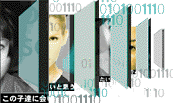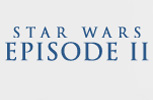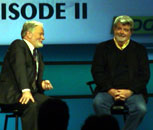 |
|   | Star Wars Episode II nears completion on CineAlta HD
George Lucas abandons film and claims digital filmmaking is an inevitability |  | |
 |
 |
 When it was first announced that director George Lucas was planning to shoot the second 'Star Wars' prequel entirely on CineAlta high definition cameras there were some sceptics who refused to believe he would abandon film altogether.
When it was first announced that director George Lucas was planning to shoot the second 'Star Wars' prequel entirely on CineAlta high definition cameras there were some sceptics who refused to believe he would abandon film altogether.
Yet that is what he has done. After the experience shooting 'Episode II' on 24P CineAlta HDCAMs Lucas has emphatically declared that he will never again shoot a feature film on 35mm film.
ìI think I can safely say Iíll never ever shoot another film on film,î said Lucas. ìThe same goes for digital editing. Iíve been editing digitally for over 15 years and I wonít go back to a linear way of working.î
The 'Episode II' production, which began principal photography in Australia last June, deployed six CineAlta HDCAM units with dual audio channels, one permanently sited on a technicrane and another fitted to a steadicam. They were equipped with a range of Panavision optics including four 9.5-105mm zooms, a 5mm prime and three 6-27mm T1.6 lenses. The Panavision glass is colour matched so when scenes from different cameras are intercut they do so seamlessly. Although VTRs were used for down conversion and cloning, the video masters were the HDCAM tapes.
One of the reasons 24P facilitates virtual content production so well is that it opens up the possibility of real-time blue and green screen shots. There is no need for film scanning and since the texture of the image is electronic and has no film grain, itís easier to integrate with CGI. The lack of time delay potentially tightens communications between the visual effects crew and the live production crew. Instant dailies confirm the success to which practical and pyrotechnic effects play on-screen.
 ìWe shot 'Episode I' with exactly the same number of crew and exactly the same number of days as 'Episode II' but we were able to go from 26 to 37 set ups a day and shave three days off the scheduled shoot largely by not having to spend an extra hour watching the dailies and not having to reload each time the film runs out,î Lucas says. ìIt really does speed up the process.
ìWe shot 'Episode I' with exactly the same number of crew and exactly the same number of days as 'Episode II' but we were able to go from 26 to 37 set ups a day and shave three days off the scheduled shoot largely by not having to spend an extra hour watching the dailies and not having to reload each time the film runs out,î Lucas says. ìIt really does speed up the process.
ìFor years weíve been trying to push the industry in this direction but Iíve always found myself up against technology which says you canít do that here or do that there. Sony however has been a leader in the field. Right from the beginning of our relationship weíve conducted tests. Weíve gone over the entire process with a lot of key scenes. Weíve looked at it on film, weíve looked at it with digital projection. Digital is just another capture medium. It doesnít change the job I do except that the cameras are lighter, easier to use and more malleable to change.î
Digital acquisition is key to Lucasí vision of a totally non-linear filmmaking technique in which he can alter effects in-camera immediately after shooting or tweak shots at any point of production. For Episode II, ILM has developed customised software which allows him to view each shot at a glance on a kind of electronic clipboard which is automatically updated whenever the image is altered.
 ìWe work in very unique way,î Lucas explains. ìI never see a normal picture on a monitor but one with elements shot against a blue screen. The elements are shot at completely different times with different backgrounds at different levels mixed with CG elements from Macs or SGIs. Its like a palette on which we perform 3D editing. You have to cut levels of elements together. We could be dealing with as many as twenty per frame. Weíre constantly cutting people out or exchanging pairs of eyes or deleting a blink. If someone moves their head at the wrong time we can change that or extend a moment in time by seven extra frames.î
ìWe work in very unique way,î Lucas explains. ìI never see a normal picture on a monitor but one with elements shot against a blue screen. The elements are shot at completely different times with different backgrounds at different levels mixed with CG elements from Macs or SGIs. Its like a palette on which we perform 3D editing. You have to cut levels of elements together. We could be dealing with as many as twenty per frame. Weíre constantly cutting people out or exchanging pairs of eyes or deleting a blink. If someone moves their head at the wrong time we can change that or extend a moment in time by seven extra frames.î
He adds: ìDigital filmmaking is inevitable. Iím not trying to convert people. Iím simply using the system and letting people know how it worked for me. The film industry is only now catching up with the digital revolution that has been happening in the broadcast environment for a long, long time now.î
|
|
|
|
|